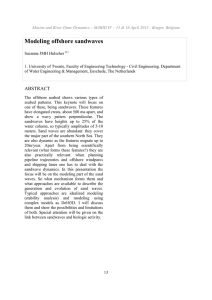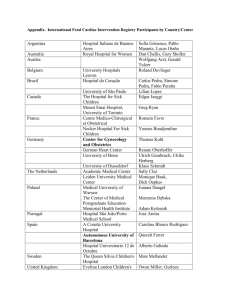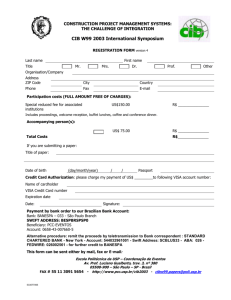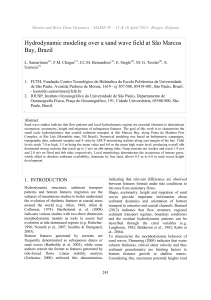Sand waves morphology and small-scale migration at a
advertisement
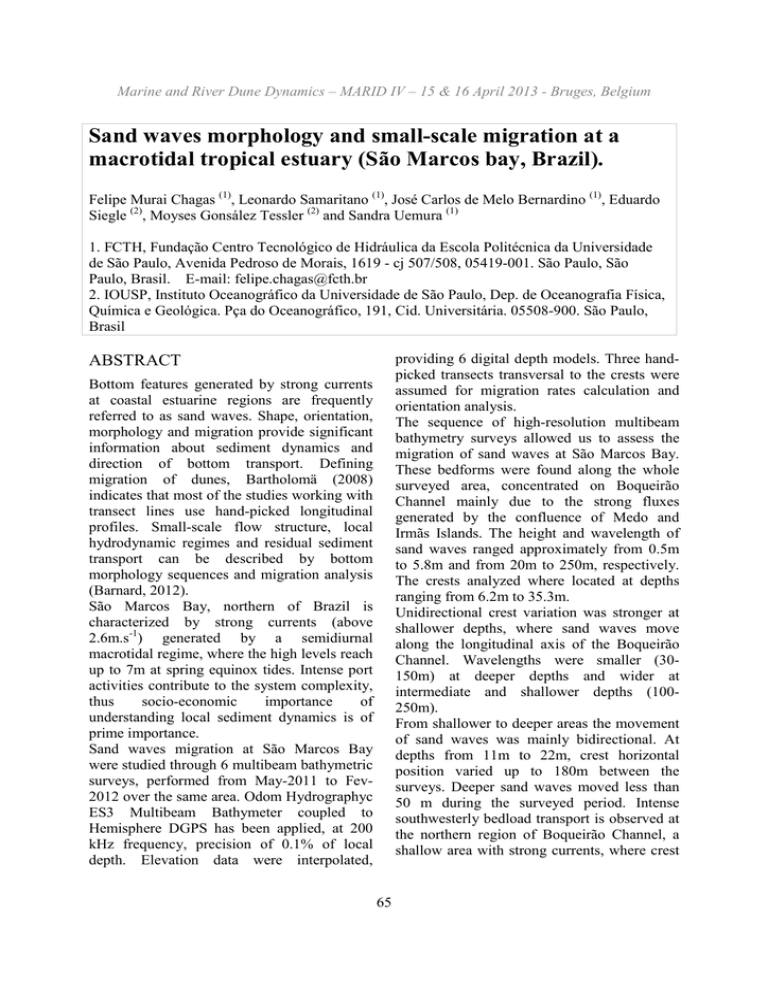
Marine and River Dune Dynamics – MARID IV – 15 & 16 April 2013 - Bruges, Belgium Sand waves morphology and small-scale migration at a macrotidal tropical estuary (São Marcos bay, Brazil). Felipe Murai Chagas (1), Leonardo Samaritano (1), José Carlos de Melo Bernardino (1), Eduardo Siegle (2), Moyses Gonsález Tessler (2) and Sandra Uemura (1) 1. FCTH, Fundação Centro Tecnológico de Hidráulica da Escola Politécnica da Universidade de São Paulo, Avenida Pedroso de Morais, 1619 - cj 507/508, 05419-001. São Paulo, São Paulo, Brasil. E-mail: felipe.chagas@fcth.br 2. IOUSP, Instituto Oceanográfico da Universidade de São Paulo, Dep. de Oceanografia Física, Química e Geológica. Pça do Oceanográfico, 191, Cid. Universitária. 05508-900. São Paulo, Brasil providing 6 digital depth models. Three handpicked transects transversal to the crests were assumed for migration rates calculation and orientation analysis. The sequence of high-resolution multibeam bathymetry surveys allowed us to assess the migration of sand waves at São Marcos Bay. These bedforms were found along the whole surveyed area, concentrated on Boqueirão Channel mainly due to the strong fluxes generated by the confluence of Medo and Irmãs Islands. The height and wavelength of sand waves ranged approximately from 0.5m to 5.8m and from 20m to 250m, respectively. The crests analyzed where located at depths ranging from 6.2m to 35.3m. Unidirectional crest variation was stronger at shallower depths, where sand waves move along the longitudinal axis of the Boqueirão Channel. Wavelengths were smaller (30150m) at deeper depths and wider at intermediate and shallower depths (100250m). From shallower to deeper areas the movement of sand waves was mainly bidirectional. At depths from 11m to 22m, crest horizontal position varied up to 180m between the surveys. Deeper sand waves moved less than 50 m during the surveyed period. Intense southwesterly bedload transport is observed at the northern region of Boqueirão Channel, a shallow area with strong currents, where crest ABSTRACT Bottom features generated by strong currents at coastal estuarine regions are frequently referred to as sand waves. Shape, orientation, morphology and migration provide significant information about sediment dynamics and direction of bottom transport. Defining migration of dunes, Bartholomä (2008) indicates that most of the studies working with transect lines use hand-picked longitudinal profiles. Small-scale flow structure, local hydrodynamic regimes and residual sediment transport can be described by bottom morphology sequences and migration analysis (Barnard, 2012). São Marcos Bay, northern of Brazil is characterized by strong currents (above 2.6m.s-1) generated by a semidiurnal macrotidal regime, where the high levels reach up to 7m at spring equinox tides. Intense port activities contribute to the system complexity, thus socio-economic importance of understanding local sediment dynamics is of prime importance. Sand waves migration at São Marcos Bay were studied through 6 multibeam bathymetric surveys, performed from May-2011 to Fev2012 over the same area. Odom Hydrographyc ES3 Multibeam Bathymeter coupled to Hemisphere DGPS has been applied, at 200 kHz frequency, precision of 0.1% of local depth. Elevation data were interpolated, 65 Marine and River Dune Dynamics – MARID IV – 15 & 16 April 2013 - Bruges, Belgium migration reached 50m.month-1 from Jul-2011 to Sep- 2011. In the central part of the studied area, where intermediate depths occur, a standard transport direction has been observed. From May-2011 to Sep-2011northwesterly movement has dominated in 2 main crests, while from Sep2011 to Nov-2011 a strong southward change of position has occurred. Hand-picked transects analysis indicate that São Marcos Bay’s main bedforms are dynamic and move along the longitudinal axis of the leading channels, influenced by the strong fluxes of currents and exhibiting intense growth and decay along small scale periods, typically under one month. REFERENCES Bartholomä A., Schrottke K., Winter C., 2008. Sand wave dynamics: Surfing between assumptions and facts. In: Parsons, D., T. Garlan and J. Best (eds) Marine and River Dune Dynamics, p. 17-24. Barnard P.L., Hanes D.M., Erikson L.H.; Rubin D.M., Dartnell P., Kvitek R.G. 2012. Analyzing bedforms mapped using multibeam sonar to determine regional bedload sediment transport patterns in the San Francisco Bay coastal system. In: Li M., Sherwood C., Hill P. Special Publication Book on Self Sedimentology, 33 pp. An. de l'Inst. Océanog. 59:117-126. . 66

